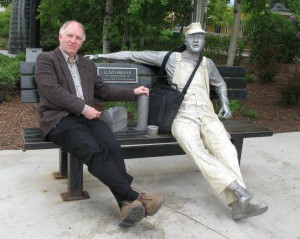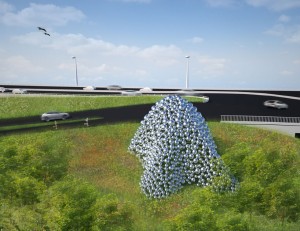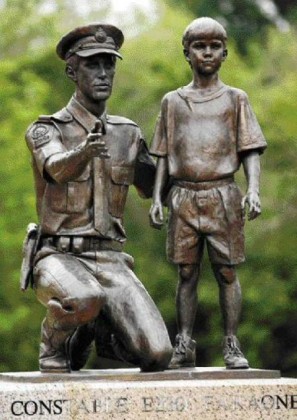What’s the point of public art? The clue is in your wallet
Posted on May 31, 2012 By Stuart Adams Culture, Front Slider, Visual Arts
 To get the balls rolling – over 1,000 of them – I LIKE the Talus Dome sculpture.
To get the balls rolling – over 1,000 of them – I LIKE the Talus Dome sculpture.
I find myself looking for it as I drive towards the Quesnell Bridge. The shiny balls catch your eye from a distance – a welcoming just before you launch across the broad expanse of pavement and concrete. The bright image is pleasing once you get closer (unlike the giant retina scorching video screen at the Westmount Mall intersection). On foot, it’s not just a pyramid of little balls on top of big balls. It has an irregular shape like a clover leaf with big balls among little ones, and you can see between them, which gives the shininess a quirky texture. How DO those metal balls still manage to shine after an Edmonton winter? Stainless steel – and it cost $600,000.
People hate the Talus Dome. They write letters to the editor about how it’s a waste of money that could have been better spent on … fill in the blank: police officers, homeless shelters, cancer research.
So, once again, a public art piece has attracted disgruntled criticism, which begs the question: What’s the point of public art?
It’s hard not to find it. In Old Strathcona, there are dozens of electrical transformers on concrete bases – dull gray boxes transformed into works of art by painters. Some are great – two by Edmonton illustrator Cindy Revell, who just happens to have been nominated for a Governor-General’s award for children’s illustration, are especially good – while some of them are so-so. ALL of them brighten their surroundings. Coming upon a new one is a treat. Graffiti artists have, for the most part, left them alone – a telling sign.
You can find a steel canoe downtown: “Caravel” by Isla Burns on the north side of City Hall, as well as the pair of huge brilliant abstract canvases by Doug Haynes, “Morning Light” and “A Promise of Dusk,” in the City Room of the same building.
Oh, and let’s not forget “Lunchbreak” – the carpenter on the bench, which has become Edmonton’s iconic public artwork since it was installed in Sir Winston Churchill Square in 1983. Interestingly, there are more versions of this piece. There’s one in Washington, D.C. at an out-of-the-way mall, as well as in Cincinnati and two cities in New Jersey. The artist, J. Seward Johnson Jr., is an interesting story himself.
The discussion of public art is especially relevant now because the City has just put the first installment of its public art collection on-line. It has so far catalogued 55 of the more than 200 public artworks scattered around town.
John Mahon, Executive Director of the Edmonton Arts Council, which administers Edmonton’s public art collection, puts some perspective on this issue, starting with the question he gets all the time: How does he justify the expense?
 Let’s start with Talus. From a financial position, he says, much of the $600,000 was spent on labour, structural engineering and fabrication costs. For instance, $40,000 alone went to welders who did the final assembly, and at the end of the day, only about 10 percent of the total went to the artists.
Let’s start with Talus. From a financial position, he says, much of the $600,000 was spent on labour, structural engineering and fabrication costs. For instance, $40,000 alone went to welders who did the final assembly, and at the end of the day, only about 10 percent of the total went to the artists.
Mahon also addresses the site location, “Some people say that’s not a very important site, but public space is fraught with symbolism,” adding that the work has to be adjacent to the project which generated the funding (Percent for Art). The sculpture is intended as a “response to the river.”
Finally, some reflection is necessary.
“We need to give it time,” Mahon says. “In the art world, we need to give it 10 years.”
And at the end of that time? If the work is not accepted, then it may indeed be de-accessioned – removed from the collection and the public eye. “Lunchbreak” is safe. It has become an Edmonton icon (when I was photographing Mahon with the sculpture, top image, he invited a passing mother and her children to be in the picture and she declined, saying, “We’ve already had our picture taken with it”).
But “The Migrants,” by Lionel Thomas, was vilified when it was unveiled as part of the 1957 City Hall construction. The folded and bent abstract steel rods were intended to suggest geese, but it was ridiculed as “The Spaghetti Tree.” Today, however, it is accepted as another abstract sculpture and fills an alcove of the current City Hall. It has passed the test of time.
As for the “squandering of funds” that could be used for things like more police officers, Mahon takes exception to then-Police Chief Doug McNally’s contention that the approximately $150,000 earmarked for art in a new Jasper Place police station could “put two officers on the street for a year.”
The practical side of Mahon notes that that would only be for one year – but he says that he would also offer McNally a story.
 “I’d say to Doug I think that the art actually has an impact on the city that helps you with your work as a policeman,” he says, citing the Danek Mozdzenski sculpture of Constable Ezio Faraone in the small, Grandin-area park that bears his name. The bronze sculpture, depicting Faraone helping a small child, inspired Mahon’s own daughters to see policemen as protectors and caregivers. “So, they’re very cooperative and they’re inclined to be that way,” he says.
“I’d say to Doug I think that the art actually has an impact on the city that helps you with your work as a policeman,” he says, citing the Danek Mozdzenski sculpture of Constable Ezio Faraone in the small, Grandin-area park that bears his name. The bronze sculpture, depicting Faraone helping a small child, inspired Mahon’s own daughters to see policemen as protectors and caregivers. “So, they’re very cooperative and they’re inclined to be that way,” he says.
He adds that the long-term impact of public cannot be measured, but he believes that such community sentiments contribute to a more enforceable city – if only to reduce vandalism – but more logically to promote community spirit and pride.
And as for funding the work of out-of-town artists, Mahon says that if public art is going to hold up, it needs to go further afield. He dismisses the notion of “world class art,” saying that it can’t be defined. But Edmonton’s efforts are attracting more and more attention, both nationally and internationally. The implication is that if Edmonton’s public art program is not a local, make-work project, and if the city is to produce quality artists, it has to allow them to compete on a larger scale. Interestingly, Calgary’s public art budget is triple that of Edmonton’s.
If you’re still skeptical about the value of public art, here’s a trivia question for you: what’s the most widely known Canadian public art piece? The answer is probably in your wallet.
Pull out a twenty dollar bill – a work of art in itself, depicting the famous Bill Reid sculptures “Raven and the First Men” and “Spirit of Haida Gwaii” – and notice the inscription on the left side, a quote by French-Canadian author Gabrielle Roy: “Could we ever know each other in the slightest without the arts?”











